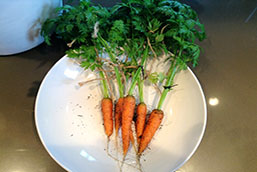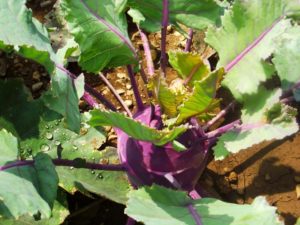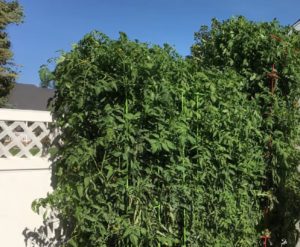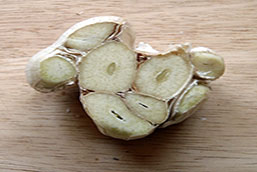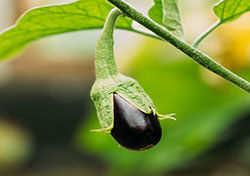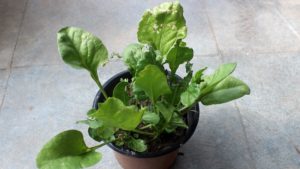So you are looking to learn how to grow your own carrots at home? Great, let’s start. Don’t worry, it’s easy and i’ll guide you on each step.
If you’ve been to any farmers’ market, chances are you’ve brought home a bag of organic carrots. And why not? They’re super cheap, have tons of health benefits and great for cooking.
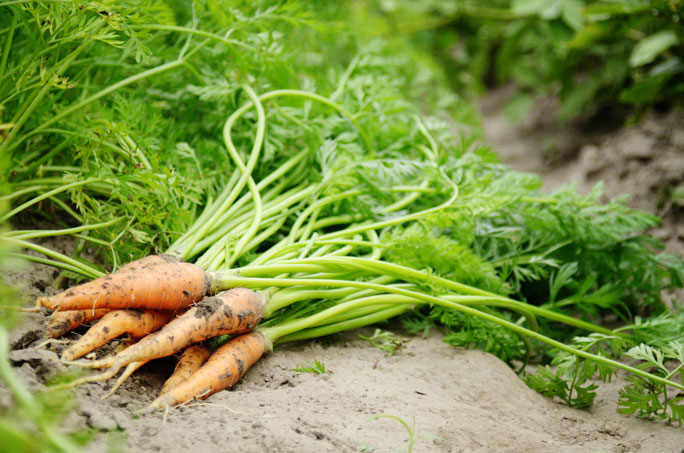
Carrots are highly nutritious. In fact, they are a very good source of antioxidants, fiber, vitamin K1, potassium, and beta carotene.
Some even believe that it is good for weight-loss too, perfect for those training their body.
What’s more, they’re perfect for cooking too! There are a ton of recipes that can highlight the fresh taste of carrots.
Either use them for soup stock or part of stuffing or why not just eat or serve them raw.
Crisp carrots are the perfect snacks to replace your bad junk food-eating habit. They’re also great as a part of a vegetable plate, just serve with a side of hummus of your favorite dressing.
But unlike most people, I don’t buy them on the farmers’ market, instead, I grow them myself!
I’ve been growing carrots at home for years now, and I use it mainly for cooking. So far, I’ve seen a lot of success in growing carrots at home and it’s just been a good experience, overall.
It’s just fun to grow a lot of food even in such a small space.
Being surrounded by vegetables grown in containers makes gardening super worth it.
Plus, I am having a great time watching it yield so many carrots year after year.
I thought I could share with you how I grow carrots at home. I can give you a detailed guide on growing carrots, that by the end you’ll be harvesting a healthy batch of them.
How To Grow Carrots
Difficulty Level, Maintenance, And Other Advantages
Carrots are an extremely fun vegetable to grow. They are very rewarding if you plant and grow them correctly.
I promise you that growing carrots is not that hard. If we are talking about the difficulty level; I would say the difficulty level is medium.
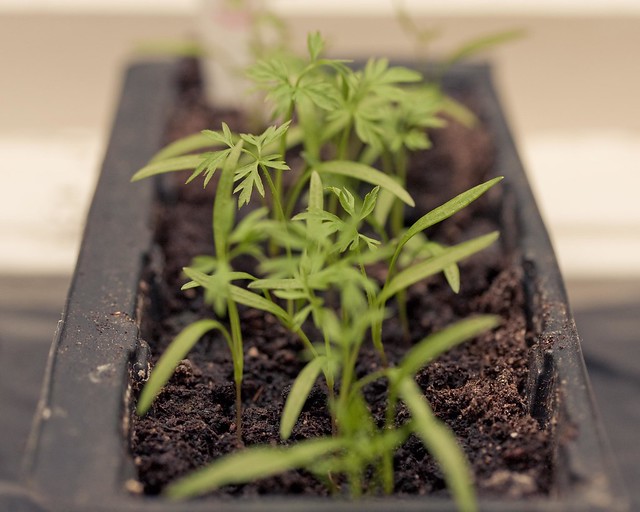
And it can be easier when you have the right tools, information and me! Let me guide you on your whole plant growing journey.
Whether you’re just starting your own garden or you’ve done this a bunch of times, you’ll have a better chance of harvesting healthy crops if you know all the things you need to know about growing this vegetable.
And this is exactly it! I have compiled all the things you need to know about carrots: sowing, growing, and harvesting.
You don’t need to go anywhere. All the questions you might ask in every step of the way is already answered and waiting for you down below.
All you need to do is continue reading.
Listen, in this plant project you can start to see results as early as after 45 days.
And in just 60 – 65 days, when the carrots finally reach maturity, you can harvest a number of a fresh, full-sized, batch of homegrown carrots.
That is relatively fast compared to other vegetables which you have to wait to reach maturity after a couple more months.
This fast-growing, high-yield crop is definitely a popular choice for gardeners.
Have I mentioned that carrot plants do not need much maintenance after planting?
All you have to do is keep an eye on your plant and give it sufficient water from time to time. Of course, you also need to fertilize.
Just basic gardening stuff, nothing too complicated.
I promise you, carrots are among the easiest crops to grow.
Home gardeners like myself can even produce two pounds or more of fresh carrots in my own backyard.
Don’t you want to experience growing your own food?
Who knows, the next it might be you proudly selling your harvest on a local farmers’ market.
All You Need to Know About How To Grow Carrots
When is the best time to plant carrots?
Before bringing out all your garden tools and accessories check your calendar first. Not all crops can grow year-round.
Timing is key in the gardening community. You need to know when is the best time to plant your carrots.
This cool-weather vegetable is best planted in the spring (March to May).
You can start sowing seeds indoors as early as 3 weeks before your last expected local frost date.
You can harvest your carrots from late summer through fall.
You may also start earlier and sow seeds indoors as you wait for the perfect soil and weather conditions to come.
Should I use carrot seeds, transplants or sets?
The best way to start a carrot plant is by sowing seeds. Root crops, especially, just don’t transplant well.
So for today’s plant project, join me and let’s learn how to grow carrots from sowing to harvest!
Most people aren’t aware that there are actually four major types of carrots. Each one is grown in the gardens that will best suit it.
These are the four types: Danvers, Nantes, Imperator, and Chantenay.
Are you familiar with any of them? Today we’ll be focusing on the Nantes variety.
In this post, I’ll be planting Scarlet Nantes carrots. I got mine from Amazon for a very cheap price and it turned out to be a great success.
If you prefer to use Danvers carrots, that is perfectly fine. The pot we will be using later will be good for either of the two.
Also, Nantes carrots have a more tender texture and are sweeter than the Danvers carrots.
Scarlet Nantes carrots are very short and doesn’t really grow very long. You can also distinguish a Nantes carrot by the roundedness of its tip and root end.
What is the best container to use when planting carrots?
For our Scarlet Nantes seeds, we will use a one and a half gallon rounded pot.
This pot is just perfect for the Scarlet Nantes since this variety doesn’t need much depth due to its shorter length.
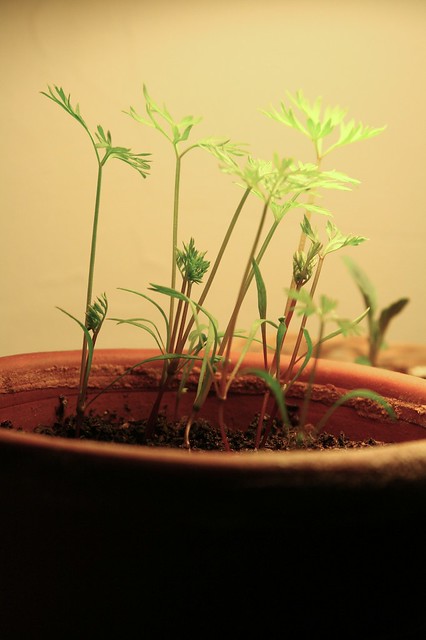
This is one of my most favorite things about growing carrots, even with limited space, I can just get a container and plant some seeds in it and it will still thrive.
Container gardening is something I am really fond about and next time I hope I can share more about it with you guys.
Just imagine your own edible garden, all the fresh vegetables ready to be picked – all tucked in their containers.
How much money you can save from growing your own food. Not to mention, how healthier your lifestyle will become.
The pot I use is actually wider than it is taller. We’re not planting a long-variety carrot so I’m sure our vegetable wouldn’t touch the bottom of the pot.
Also, their roots are just relatively shorter than other variants so we wouldn’t be needing that much depth.
Most of the nurseries just throw out this rounded container at the end of the season. You can ask them if there are any available containers left.
Who knows, you might just score one for free. These types of containers are also very durable and will last for many years.
If you can’t wait until then, you can always order one from Amazon. It’s not that expensive and since it will last for many years, it’s worth investing your money on.
You can harvest about six to seven carrots from a pot this size. If you want a greater crop yield, you can always plant more carrots into more containers.
You also just need one bag of seeds. Each bag contains a very large amount of seeds that will be enough for even more than 10 pots.
How do I prepare the soil for planting carrots?
Generally, carrots thrive in sandy or loamy soil with a pH of 5.5-6.5. But carrots grown in pots work best in a very well-draining potting mix.
We can’t actually replicate the soil condition of the garden ground that makes it perfectly loose so the best we can do is use a standard potting-specific mix.
Growing carrots, one of the most important things to focus on is preparing the soil for planting.
Carrot is a root vegetable so the condition of the soil should be perfect.
After making sure that your soil has the qualities that I’ve mentioned above here are some guidelines to follow:
- Remove any stones on the soil or in your potting mix, it might stunt or misshapen your carrots
- Properly cultivate the soil before planting, make sure it’s super loose so the crop can push through easily
- If you don’t want janky looking carrots, avoid using too much fertilizer or manure. Never use them before planting your carrot seeds.
Again, a well-prepared soil is vital to the healthy growth of your carrots so make sure you give proper attention to this step.
How do I plant carrots?
After filling your container with the potting mix (make sure to gently pat the soil down to even it out), it’s time to sow the carrot seeds. Follow these short steps on planting carrots.
- Sow the seeds two inches apart and about one-inch deep
- Place two to three seeds in every hole
- Cover the holes and water them
Hurrah! You are done with the planting part, the simplest part of your home-grown carrot journey. It’s time to discuss plant care.
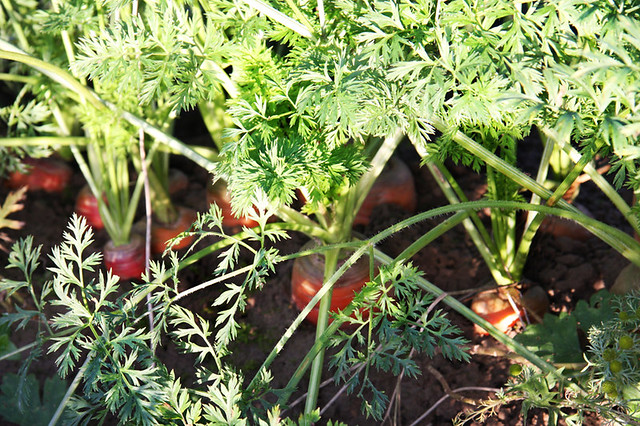
Growing Carrots
How and when do I thin my carrot plant?
Thin the seedlings when they start to have three true leaves or are at least 1 inch tall about. Space them four inches apart. Use scissors to remove the weaker smaller ones by cutting them at soil-levels.
How can I properly water my carrot plant?
Since we’re using a pot, we need to water them more frequently. I suggest you regularly water them 2 to 3 times a week.
Which fertilizer should I use for my carrot plants and when do I use it?
As I’ve said earlier, I don’t fertilize my soil before the carrot seeds are intact. I only fertilize once a month.
Since this particular variety only needs 60 to 65 days to mature, I’ve only fertilized them twice during the whole growing period making sure the carrots are healthy.
I suggest using an all-purpose fertilizer, it’s a tried and tested one that takes care of my growing carrots.
You don’t need the fancy ones, most of them will only cause bigger leaves and not bigger carrots anyways.
How much sun does my carrot plant need?
Carrots are sun-loving plants, they thrive in full sunlight.
In my own garden, I give my carrot plants seven to ten hours of full sun.
They need this much sunlight since they use all their energy from their leaves to create larger carrots underground.
Which climate better suits carrots? (Best Hardiness Zones)
Carrots can mostly grow in many climates but they are perfect plants to grow in the cooler ends of the growing season.
This cool-weather vegetable is generally suitable for the U.S. Department of Agriculture hardiness zones 3 through 10.
How long does it take to grow carrots and what should I expect in each growing stage?
Depending on the local growing conditions, Scarlet Nantes typically is ready for harvest in about 60 to 65 days from sowing seeds.
In 14 to 21 days, you can expect germination. Carrots are slow to germinate. In about 40 days you can see its true leaves.
And in 60 to 65 days, a tiny orange head or crown will appear at the soil line.
What are the common diseases and pests that could ruin my carrot plant and how do I avoid it?
After planting your carrots and seeing them mature over the weeks, I’m sure you’ll be feeling a certain sense of accomplishment.
However, do not let your guard down and keep a steady eye on your plants. There are a number of diseases and pests that might attack it.
Good thing I’ve listed some of the problems you might encounter while growing carrots down below. I’ve also included what to do to prevent or control them.
- Carrot Rust
Carrot rust flies lay their eggs in the soil around the top of carrot plants and causes Carrot rust.
The eggs that will hatch into larva will eventually dig down into the soil, and into the carrot’s roots. The larva will then proceed to munch rust-colored tunnels in the carrot. You can see this usually in the lower two-thirds of the root.
Avoid this problem by planting your carrots under Reemay.
2. Alternaria blight (Alternaria dauci)
You can spot this disease when you observe brown-black lesions edged with yellow on leaf margins, starting on the oldest leaves. It causes leaflets to curl and eventually die. It may stunt the carrot root’s growth.
Avoid this problem by not splashing water on leaves. Employ drip irrigation or just water plant in the morning. Plant resistant cultivars. Do not overcrowd plants.
3. Cercospora blight (Cercospora carotae)
You can spot this disease when you observe small, dark spots with yellow margins, on the carrot’s younger leaves and stems.
Avoid this problem by not splashing water on leaves. Employ drip irrigation or just water plant in the morning. Plant resistant cultivars. Do not overcrowd plants.
4. Wire Worms
These nasty critters are the larvae of click beetles. They burrow into the root and damages the carrots which might make them unmarketable.
Consider crop rotation to avoid this problem. You should also plow in the fall to expose the wireworms to the birds who’d love to eat them.
If you encounter one or some of these problems, chill out. It happens to everybody. This won’t mean that gardening isn’t for you. Do not let this discourage you from pursuing your passion for gardening.
I don’t really subscribe to the idea that only people with a green thumb can be successful in gardening or farming.
Do you know who will be successful? Those who put on the hard work and do their research. People like you who are not scared to try on different things.
What other crops could I plant together with my carrots to maximize my garden space?
You may think that building your own edible garden is a bit far-fetched for a beginner or amateur gardener like you but let me stop you right there. This vegetable garden that you’re aiming for is totally doable!
If you’re still with me and tried to follow my guidelines on growing carrots, that means there’s a big chance that you’ll have a healthy growing vegetable crop at home.
That carrot plant is just the start.
By learning more about home gardening and trying out one plant at a time, you’ll have an edible garden in no time. But to help you out even further, let me introduce you to companion planting.
What is companion planting? Simple, it’s a form of polyculture used by fellow gardeners and farmers that is believed to produce mutual benefits for certain plants and crops planted next to each other.
The idea is by planting these companion plants, the crops can help each other grow healthily on their own.
Some of the benefits include natural pest control, higher crop yield and shade protection for sun-sensitive plants.
For example, it’s ideal to plant them with radishes because radishes are harvested before the carrots resulting in a looser soil for the carrots.
Plus, companion planting maximizes your garden space! Here are some of the best companion plants for carrots:
Read more how-to-grow articles on this site, I have so many more gardening stories to share so you can add more crops to your garden!
What are the crops that will not go well with carrots?
While we can see that carrots have a great number of companion plants that we should be thankful for, there are just some plants and crops that will never go well with this vegetable.
Did you know that other root crop plants are bad neighbors for your carrots? You need to scatter your root crops in your garden so they won’t compete for available phosphorus.
Here are some of the Carrot’s bad neighbors:
- Dill
- Potatoes
- Parsnips
- Root crops
Harvesting Carrots
When is the best time to harvest carrots?
When you see the carrots ‘crowning’ or when a tiny carrot head appears above the soil line. This happens in about two months.
One way to really check of your plants are ready for harvest is by pulling up a few of them.
Pull only the carrots that you will be using, keeping them ground actually helps retain their freshness.
Gardening tip! The largest carrots usually have the darkest and greenest tops so make sure to keep an eye out on them.
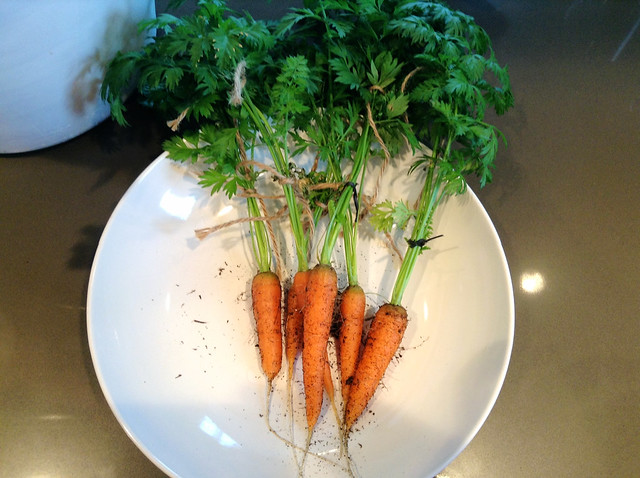
How do I harvest carrots?
To harvest, gently pull the roots out by their green tops. Don’t let your carrots grow fatter than 1 1/2″ across, or they’ll become very hard. We want crisp carrots, not wooden ones.
What is the best way to store the carrots that I have harvested?
Store freshly-harvested carrots by twisting off their green tops. Make sure to scrub off the dirt on them under cold running water.
Let them dry completely and tightly seal in plastic bags, and refrigerate.
You can store fresh carrots for up to 21 days at room temperature. At 39ºF, you can store them even longer – around two months.
Honestly speaking, I feel like I wouldn’t store my harvest if I saw how crisp and fresh this yield is.
I would just eat them raw and enjoy the taste of months of labor.
We’re finally done! I hope you enjoy growing carrots as much as I did.
I wish you had a good harvest and are ready for another round of planting. What plants would you want me to tackle next time?

